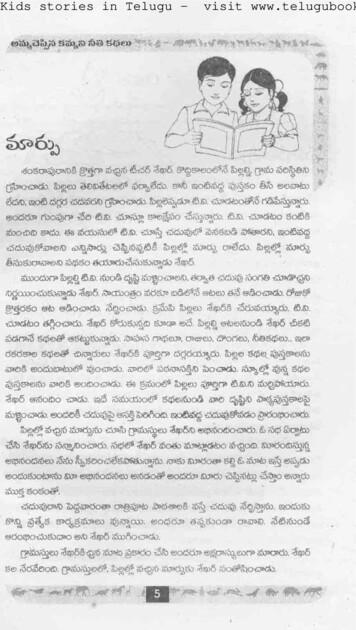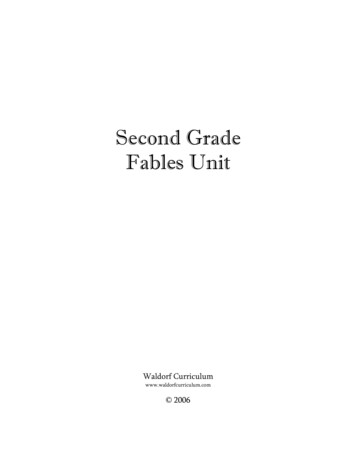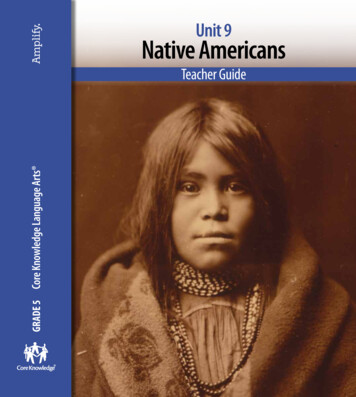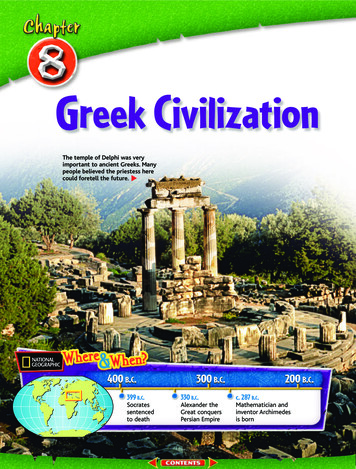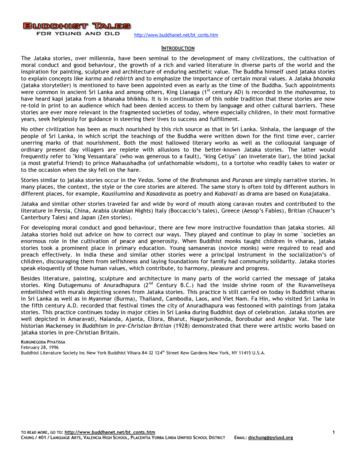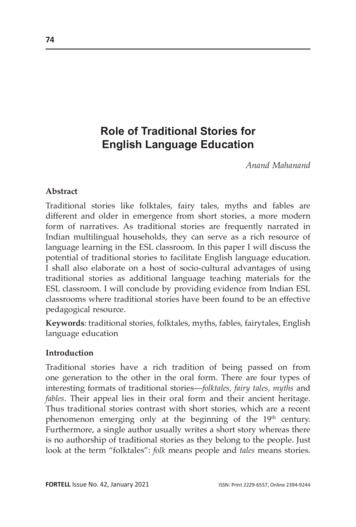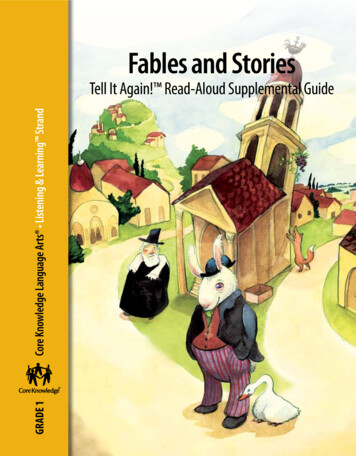
Transcription
grade 1Core Knowledge Language Arts Listening & Learning StrandFables and StoriesTell It Again! Read-Aloud Supplemental Guide
Fables and StoriesSupplemental Guide to theTell It Again! Read-Aloud AnthologyListening & Learning StrandGRADE 1Core Knowledge Language Arts
Creative Commons LicensingThis work is licensed under a Creative Commons AttributionNonCommercial-ShareAlike 3.0 Unported License.You are free:to Share — to copy, distribute and transmit the workto Remix — to adapt the workUnder the following conditions:Attribution — You must attribute the work in thefollowing manner:This work is based on an original work of the CoreKnowledge Foundation made available throughlicensing under a Creative Commons AttributionNonCommercial-ShareAlike 3.0 Unported License. Thisdoes not in any way imply that the Core KnowledgeFoundation endorses this work.Noncommercial — You may not use this work forcommercial purposes.Share Alike — If you alter, transform, or build upon thiswork, you may distribute the resulting work only underthe same or similar license to this one.With the understanding that:For any reuse or distribution, you must make clear toothers the license terms of this work. The best way todo this is with a link to this web 3.0/Copyright 2013 Core Knowledge Foundationwww.coreknowledge.orgAll Rights Reserved.Core Knowledge Language Arts, Listening & Learning,and Tell It Again! are trademarks of the Core KnowledgeFoundation.Trademarks and trade names are shown in this book strictlyfor illustrative and educational purposes and are the propertyof their respective owners. References herein should notbe regarded as affecting the validity of said trademarks andtrade names.
Table of ContentsFables and StoriesSupplemental Guide to theTell It Again! Read-Aloud AnthologyPreface to the Supplemental Guide . . . . . . . . . . . . . . . . . . . . . . . . . . . . . . . . . . . . . . . . . . . . . . . . . . . . vAlignment Chart for Fables and Stories: Supplemental Guide. . . . . . . . . . . . . . . . . . . . . . . . . . . . . . . . . . . xviiIntroduction to Fables and Stories: Supplemental Guide . . . . . . . . . . . . . . . . . . . . . . . . . . . . . . . . . . . . . . . .1Lesson 1: The Boy Who Cried Wolf . . . . . . . . . . . . . . . . . . . . . . . . . . . . . . . . . . . . . . . . . . . . . . . . . . . 16Lesson 2: The Maid and the Milk Pail . . . . . . . . . . . . . . . . . . . . . . . . . . . . . . . . . . . . . . . . . . . . . . . . . . 34Lesson 3: The Goose and the Golden Eggs . . . . . . . . . . . . . . . . . . . . . . . . . . . . . . . . . . . . . . . . . . . . . . . 47Lesson 4: The Dog in the Manger . . . . . . . . . . . . . . . . . . . . . . . . . . . . . . . . . . . . . . . . . . . . . . . . . . . . 63Lesson 5: The Wolf in Sheep’s Clothing . . . . . . . . . . . . . . . . . . . . . . . . . . . . . . . . . . . . . . . . . . . . . . . . . 77Lesson 6: The Fox and the Grapes . . . . . . . . . . . . . . . . . . . . . . . . . . . . . . . . . . . . . . . . . . . . . . . . . . . . 93Pausing Point . . . . . . . . . . . . . . . . . . . . . . . . . . . . . . . . . . . . . . . . . . . . . . . . . . . . . . . . . . . . . . 107Lesson 7: The Little Half-Chick (Medio Pollito). . . . . . . . . . . . . . . . . . . . . . . . . . . . . . . . . . . . . . . . . . . . 111Lesson 8: The Crowded, Noisy House . . . . . . . . . . . . . . . . . . . . . . . . . . . . . . . . . . . . . . . . . . . . . . . . . 131Lesson 9: The Tale of Peter Rabbit. . . . . . . . . . . . . . . . . . . . . . . . . . . . . . . . . . . . . . . . . . . . . . . . . . . 145Lesson 10: All Stories Are Anansi’s. . . . . . . . . . . . . . . . . . . . . . . . . . . . . . . . . . . . . . . . . . . . . . . . . . . 163Domain Review . . . . . . . . . . . . . . . . . . . . . . . . . . . . . . . . . . . . . . . . . . . . . . . . . . . . . . . . . . . . . 179Domain Assessment. . . . . . . . . . . . . . . . . . . . . . . . . . . . . . . . . . . . . . . . . . . . . . . . . . . . . . . . . . 181Culminating Activities . . . . . . . . . . . . . . . . . . . . . . . . . . . . . . . . . . . . . . . . . . . . . . . . . . . . . . . . 184Appendix . . . . . . . . . . . . . . . . . . . . . . . . . . . . . . . . . . . . . . . . . . . . . . . . . . . . . . . . . . . . . . . . . 187
Preface to the Supplemental GuideFables and StoriesThe Supplemental Guide is designed as a companion to the CoreKnowledge Language Arts Tell It Again! Read-Aloud Anthologies. Thereis one Supplemental Guide per domain. This preface to the SupplementalGuide provides information about the guide’s purpose and targetaudience, describes how it can be used flexibly in various classroomsettings, and summarizes the features of the guide that distinguish it fromthe Tell It Again! Read-Aloud Anthologies.Intended Users and UsesThis guide is intended to be used by general education teachers,reading specialists, English as a Second Language (ESL) teachers,and special education teachers, and teachers seeking an additionalresource for classroom activities. This guide is intended to be bothflexible and versatile. Its use is to be determined by teachers to in orderto fit the unique circumstances and specific needs of their classroomsand individual students. Teachers whose students would benefit fromenhanced oral language practice may opt to use the SupplementalGuide as their primary guide for Listening & Learning. Teachers mayalso choose to begin a domain by using the Supplemental Guide astheir primary guide before transitioning to the Tell It Again! Read-AloudAnthology, or may choose individual activities from the SupplementalGuide to augment the content covered in the Tell It Again! Read-AloudAnthology. Such teachers might use the Vocabulary InstructionalActivities and some of the modified read-alouds during small-groupinstruction time. Reading specialists and ESL teachers may find that thetiered Vocabulary Charts are a useful starting point in addressing theirstudents’ vocabulary learning needs.The Supplemental Guide is designed to allow flexibility with regard tolesson pacing and encourages education professionals to pause andreview when necessary. A number of hands-on activities and graphicorganizers are included in the lessons to assist students with learning thecontent presented.Fables and Stories: Supplemental Guide Preface 2013 Core Knowledge Foundationv
Supplemental Guide ContentsThe Supplemental Guide contains modified read-alouds, tieredVocabulary Charts, Multiple Meaning Word Activities, SyntacticAwareness Activities, and Vocabulary Instructional Activities. For eachmodified read-aloud, a variety of Multiple Meaning Word Activities,Syntactic Awareness Activities, and Vocabulary Instructional Activities areavailable for classroom use, affording students additional opportunitiesto use domain vocabulary. The activities integrated into the lessons ofthe Supplemental Guide create a purposeful and systematic setting forEnglish language learning. The read-aloud of each story or nonfictiontext builds upon previously taught vocabulary and ideas and introduceslanguage and knowledge needed for the next more complex text. TheSupplemental Guide’s focus on oral language in the earlier gradesaddresses the language learning needs of students with limited Englishlanguage skills who may not be exposed to the kind of academiclanguage found in written texts outside of a school setting.Modified Read-AloudsThe modified read-alouds in the Supplemental Guide, like the readalouds in the corresponding Tell It Again! Read-Aloud Anthology, arecontent-rich and designed to build students’ listening comprehension,which is a crucial foundation for their reading comprehension abilities.Students who listen to the Supplemental Guide read-alouds will learnthe same core content as students who listen to read-alouds from thecorresponding Tell It Again! Read-Aloud Anthology.In the modified read-alouds, the teacher presents core content in aclear and scaffolded manner. Lessons are designed to be dialogicand interactive in nature. This allows students to use acquired contentknowledge and vocabulary to communicate ideas and concepts withtheir peers and teachers in an accommodating and safe environment.Maximizing time for student conversation by structuring supportivesituations, where students can engage in meaningful, collaborativediscussions with their teacher and peers, is an important catalyst to orallanguage development.Tips and Tricks for Managing the Flip Book During the Read-AloudsPlease note that many modified read-alouds ask that you show Flip Bookimages in a non-sequential order that differs from the order in which theimages are arranged in the Flip Book. Furthermore, some modified readalouds make use of Flip Book images from two or more separate lessons.viFables and Stories: Supplemental Guide Preface 2013 Core Knowledge Foundation
It is highly recommended that you preview each modified readaloud, with the Flip Book in hand, before teaching a lesson. It iscritical that you be familiar with the order of the Flip Book images for agiven read-aloud, so that you are able to confidently present the readaloud text and the appropriate image without searching through pages inthe Flip Book.We recommend that you consider using one or more of the following tipsin preparing the Flip Book prior to the read-aloud to ensure a smoothtransition in moving from one image to the next: Number the Flip Book thumbnails in each read-aloud lesson of theSupplemental Guide. Place corresponding, numbered sticky notes inthe order Flip Book images will be shown, projecting from the side ofthe Flip Book so that each number will be clearly seen. (For example,if the number “3” is written next to an image thumbnail in the readaloud, write the number “3” on a sticky note and then place this onthe appropriate image so it projects from the side of the Flip Book.) Alternatively, write the Flip Book image numbers as they appear in theread-aloud lesson of the Supplemental Guide (e.g., 4A-3) on stickynotes that project out from the side of the Flip Book so that imagenumbers are clearly visible. If you need to show images from two separate, nonconsecutivelessons, use different colored sticky notes for the different lessons.Be aware that images are printed on both sides of pages in the FlipBook. In some instances, you may need to be prepared to physicallyturn the Flip Book over to locate the next image and continue theread-aloud.Vocabulary ChartsVocabulary Chart for [Title of Lesson]Core Vocabulary words are in bold.Multiple Meaning Word Activity word is underlined.Vocabulary Instructional Activity words have an asterisk (*).Suggested words to pre-teach are in italics.Type of WordsTier 3Tier 2Tier 1Domain-Specific WordsGeneral Academic WordsEveryday-Speech WordsUnderstandingMultiple MeaningPhrasesCognatesFables and Stories: Supplemental Guide Preface 2013 Core Knowledge Foundationvii
Vocabulary Charts at the beginning of each lesson categorize words intothree tiers which are generally categorized as follows: Tier 1 words are words that are likely to appear in the basic repertoireof native English-speaking students—words such as baby, climb, andjacket. Tier 2 words are highly functional and frequently used generalacademic words that appear across various texts and content areas—words such as analysis, create, and predict. Tier 3 words are content-specific and difficult words that are crucialfor comprehending the facts and ideas related to a particularsubject—words such as photosynthesis, alliteration, and democracy.English Language Learners and students with limited oral language skillsmay not necessarily know the meanings of all Tier 1 words and may findTier 2 and Tier 3 words confusing and difficult to learn. Thus, explicitexplanation of, exposure to, and practice using Tier 1, 2, and 3 words areessential to successful mastery of content for these students (NationalGovernors Association Center for Best Practices, Council of Chief StateSchool Officers, 2010, 32–35).In addition, the Vocabulary Chart indicates whether the chosen wordsare vital to understanding the lesson (labeled Understanding); havemultiple meanings or senses (labeled Multiple Meaning); are clusters ofwords that often appear together (labeled Phrases); or have a Spanishword that sounds similar and has a similar meaning (labeled Cognates).Words in the Vocabulary Chart were selected because they appearfrequently in the text of the read-aloud or because they are words andphrases that span multiple grade levels and content areas. Teachersshould be aware of and model their use as much as possible before,during, and after each individual lesson, in addition to using these wordsto connect lessons. The Vocabulary Chart is also a good starting pointand reference for keeping track of students’ oral language developmentand retention of domain-related and academic vocabulary. These listsare not meant to be exhaustive, and teachers are encouraged to includeadditional words they feel would best serve their students.Multiple Meaning Word ActivitiesMultiple Meaning Word Activities help students determine and clarifythe different meanings of individual words. This type of activity supportsa deeper knowledge of content-related words and a realization thatviiiFables and Stories: Supplemental Guide Preface 2013 Core Knowledge Foundation
many content words have multiple meanings associated with them.Students with strong oral language skills may be able to navigatethrough the different meanings of some words without much effort.However, students with limited English language proficiency and minimalvocabulary knowledge may be less likely to disambiguate the meaningsof words. This is why it is important that teachers have a way to callstudents’ attention to words in the lesson that have ambiguous meaningsand that students have a chance to explore the nuances of words incontexts within and outside of the lessons.Syntactic Awareness ActivitiesSyntactic Awareness Activities call students’ attention to sentencestructure. During the early elementary grades, students are not expectedto read or write lengthy sentences, but might be able to produce complexsentences in spoken language when given adequate prompting andsupport. Syntactic Awareness Activities support students’ awarenessof the structure of written language, relationships between words,and grammar. Developing students’ oral language through syntacticawareness provides a solid foundation for written language developmentin the later elementary grades and beyond.Vocabulary Instructional ActivitiesVocabulary Instructional Activities are included to build students’ generalacademic, or Tier 2, vocabulary. These words are salient because theyappear across content areas and in a variety of written texts. TheseVocabulary Instructional Activities support students’ learning of Tier2 words and deepen their knowledge of academic words and theconnections of these words to other words and concepts. The vocabularyknowledge students possess is intricately connected to readingcomprehension, and the ability to access background knowledge, expressideas, communicate effectively, and learn about new concepts.English Language Learners and Students with DisabilitiesThe Supplemental Guide assists education professionals who servestudents with limited English language skills or students with limitedhome-literacy experience, which may include English Language Learners(ELLs) and students with special needs. Although the use of this guideis not limited to teachers of ELLs and/or students with special needs,the following provides a brief explanation of these learners and theFables and Stories: Supplemental Guide Preface 2013 Core Knowledge Foundationix
challenges they may face in the classroom, amd outlines teachingstrategies that address those challenges.English Language LearnersThe Supplemental Guide is designed to facilitate the academic orallanguage development necessary for English Language Learners (ELLs)to fully participate in the read-alouds and activities in the Tell It Again!Read-Aloud Anthology, and to strengthen ELLs’ understanding of thecore content presented in the Anthologies.When teaching ELLs, it is important to keep in mind that they are aheterogeneous group from a variety of social backgrounds and atdifferent stages in their language development. There may be someELLs who do not speak any English and have little experience in aformal education setting. There may be some ELLs who seem fluentin conversational English but do not have the academic languageproficiency to participate in classroom discussions about academiccontent. The following is a chart showing the basic stages of secondlanguage acquisition; proper expectations for student behavior andperformance; and accommodations and support strategies for eachstage. Please note that ELLs may have extensive language skills in theirfirst language, and that they advance to the next stage at various ratesdepending on their acculturation, motivation, and prior experiences in aneducational setting.xFables and Stories: Supplemental Guide Preface 2013 Core Knowledge Foundation
LanguageAcquisition StageComprehensionand ProductionAccommodations andSupport StrategiesPreproduction(“The Silent Period”) Produces little or no English May refuse to say or doanything Responds in non-verbal ways Has a minimal receptivevocabulary in English Use predictable phrases for set routines Use manipulatives, visuals, realia, props Use Total Physical Response (TPR) to indicatecomprehension (point, nod, gestures) Use lessons that build receptive vocabulary Pair with another ELL who is slightly moreadvanced in oral language skills for activities anddiscussions focused on the English language Pair with same language peers for activities anddiscussions focused on content Use simple questions that require simplenonverbal responses (e.g., “Show me ,” “Circlethe ”) Use a slow rate of speech and emphasize keywords Model oral language, but do not force student toproduce oral languageEarly Production Responds with one- or twoword phrases Understands basic phrasesand words Uses abundant fillers, e.g.,“er” and “um,” when speaking Includes frequent long pauseswhen speaking Has basic level of Englishvocabulary (common wordsand phrases) Use repetition, gestures, and visual aids tofacilitate comprehension and students’ responses Use small group activities Use charades and linguistic guessing games Use role playing activities Use lessons that expand receptive and expressivevocabulary Use increasingly more difficult question types asstudents’ receptive and expressive language skillsimprove: Yes/no questions Either/or questions Questions that require short answers Open-ended questions to encourage expressiveresponses Pair with another ELL who is slightly moreadvanced in oral language skills for activities anddiscussions focused on the English language Pair with same-language peers for activities anddiscussions focused on content Allow for longer processing time Continue to allow participation to be voluntaryFables and Stories: Supplemental Guide Preface 2013 Core Knowledge Foundationxi
Speech Emergence(Low Intermediate) Speaks in short phrases andsimple sentences Makes multiple grammaticalerrors Begins to use context to inferthe meanings of unknownwords heard or read Can produce some narrativesand understand some detailsof a story Uses many fillers, e.g., “um”and “like,” when speaking Repeats individual phrasesmultiple times Has a much larger receptivethan expressive vocabulary inEnglish Model correct language formsUse more complex stories and booksStart to focus on Tier 2 vocabularyPair with high-level English speakers for activitiesand discussions focused on the English language Provide some extra time to respond Use increasingly difficult question types asstudents’ receptive and expressive language skillsimprove: Questions that require short sentence answers Why and how questions Questions that check for literal and abstractcomprehension Engage students in producing languageIntermediate Fluency(High Intermediate) Engages in conversationsProduces connected narrativeMakes few grammatical errorsUses some fillers whenspeaking Shows good comprehension Has and uses expandedvocabulary in English Model correct language forms Introduce academic terms (e.g., makingpredictions and inferences, figurative language) Use graphic organizers Pair with native English speakers Use questions that require opinion, judgment, andexplanationAdvanced Fluency Uses English that nearlyapproximates the language ofnative speakers Understands mostconversations and canmaintain a two-wayconversation Uses more complexgrammatical structures, suchas conditionals and complexsentences Has and uses an enrichedvocabulary in English Continue to build background knowledge Build high-level/academic language Expand figurative language, (e.g., by usingmetaphors and idioms Focus on high-level concepts Pair with students who have a variety of skills andlanguage proficiencies Use questions that require inference andevaluation(Adapted from Hirsch and Wiggins 2009, 362–364; Smyk et al. 2013)xiiFables and Stories: Supplemental Guide Preface 2013 Core Knowledge Foundation
Students with Disabilities and Students with Special NeedsStudents with disabilities (SWDs) have unique learning needs that requireaccommodations and modifications to the general education curriculum.When using the Supplemental Guide with SWDs and students withspecial needs, it is important to consider instructional accommodations,tools, strategies, and Universal Design for Learning (UDL) Principles,which promote learning for all students through the use of multiple formsof representation, expression, and engagement (Hall, Strangman, andMeyer 2003).PacingPacing is the purposeful increase or decrease in the speed of instruction.Educators can break lessons into manageable chunks depending onthe needs of the class and follow the section with a brief review ordiscussion. This format of instruction ensures that students are notinundated with information. Additionally, you may want to allow studentsto move around the room for brief periods during natural transition points.When waiting for students to respond, allow at least three seconds ofuninterrupted wait time to increase correctness of responses, responserates, and level of thinking (Stahl 1994).Goals and ExpectationsMake sure that students know the purpose and desired outcome of eachactivity. Have students articulate their own learning goals for the lesson.Provide model examples of desired end-products. Use positive verbalpraise, self-regulation charts, and re-direction to reinforce appropriateways for students to participate and behave.DirectionsProvide reminders about classroom rules and routines wheneverappropriate. You may assign a partner to help clarify directions. Whennecessary, model each step of an activity’s instructions. Offering explicitdirections, procedures, and guidelines for completing tasks can enhancestudent understanding. For example, large assignments can be deliveredin smaller segments to increase comprehension and completion(Franzone 2009).Instruction Format and GroupingUse multiple instruction formats (e.g., small-group instruction, individualwork, collaborative learning, and hands-on instruction). Be sure to groupstudents in logical and flexible ways that support learning.Fables and Stories: Supplemental Guide Preface 2013 Core Knowledge Foundationxiii
Instructional StrategiesThe following evidence-based strategies can assist students withdisabilities in learning content (Scruggs et al. 2010): Mnemonic strategies are patterns of letters and sounds related toideas that enhance retention and recall of information. They can beused as a tool to encode information. Spatial organizers assist student understanding and recall ofinformation using charts, diagrams, graphs, and/or other graphicorganizers. Peer mediation, such as peer tutoring and cooperative learninggroups, can assist in assignment completion and enhancecollaboration within the classroom. Hands-on learning offers students opportunities to gainunderstanding of material by completing experiments and hands-onactivities that reinforce content. Explicit instruction utilizes clear and direct teaching using smallsteps, guided and independent practice, and explicit feedback. Visual strategies (e.g., picture/written schedules, story maps, taskanalyses, etc.) represent content in a concrete manner to increasefocus, communication, and expression (Rao and Gagie 2006).Referencesxiv1.Biemiller, Andrew. 2010. Words Worth Teaching. Columbus: SRA/McGrawHill.2.Franzone, Ellen L. 2009. “Overview of Task Analysis.” Madison, WI:National Professional Development Center on Autism SpectrumDisorders, Waisman Center, University of Wisconsin.3.Hall, Tracey, Anne Meyer and Nicole Strangman. 2003.“Differentiated Instruction and Implications for UDL Implementation.”National Center on Accessing the General Curriculum.4.Hirsch, Jr., E. D. and Alice K. Wiggins. 2009. Core KnowledgePreschool Sequence and Teacher Handbook. Charlottesville, VA:Core Knowledge Foundation.Fables and Stories: Supplemental Guide Preface 2013 Core Knowledge Foundation
5.National Governors Association Center for Best Practices, Council ofChief State School Officers. 2010. “Appendix A,” in Common CoreState Standards: English Language Arts Standards. Washington DC:National Governors Association Center for Best Practices, Council ofChief State School Officers.6.Rao, Shaila M. and Brenda Gagie. 2006. “Learning Through Seeingand Doing: Visual Supports for Children with Autism.” TeachingExceptional Children 38 (6): 26–33.7.Scruggs, Thomas E., Margo A. Mastropieri, Sheri Berkeley, andJanet E. Graetz. 2010. “Do Special Education Interventions ImproveLearning of Secondary Content? A Meta-Analysis.” Remedial andSpecial Education 31: 437–449.8.Smyk, Ekaterina, M. Adelaida Restrepo, Joanna S. Gorin, andShelley Gray. 2013. “Development and Validation of the SpanishEnglish Language Proficiency Scale (SELPS).” Language, Speech,and Hearing Services in Schools 44: 252–65.9.Stahl, Robert J. 1990. “Using ‘Think-Time’ Behaviors to PromoteStudents’ Information Processing, Learning, and On-TaskParticipation: An Instructional Module.” Tempe, AZ: Arizona StateUniversity.Fables and Stories: Supplemental Guide Preface 2013 Core Knowledge Foundationxv
Alignment Chart for Fables and Stories: Supplemental GuideThe following chart contains core content objectives addressed in thisdomain. It also demonstrates alignment between the Common CoreState Standards and corresponding Core Knowledge Language Arts(CKLA) goals.Alignment Chart forFables and Stories: Supplemental GuideLesson12345678910Core Content Objectives Demonstrate familiarity with various fables and storiesDescribe the characters, plot, and setting of a specificfable or storyIdentify specific stories as a fable or folktale Identify characteristics of fables: short, moral,personificationExplain in their own words the moral of a specific fable Reading Standards for Literature: Grade 1Key Ideas and DetailsSTD RL.1.1CKLAGoal(s)STD RL.1.2CKLAGoal(s)Ask and answer questions about key details in a text.Ask and answer questions (e.g., who,what, where, when), orally or in writing,requiring literal recall and understandingof the details, and/or facts of a fictionread-aloud Answer questions that require makinginterpretations, judgments, or givingopinions about what is heard in a fictionread-aloud, including answering whyquestions that require recognizingcause/effect relationships Retell stories, including key details, and demonstrate understanding of their central message or lesson.Retell fiction read-alouds including keydetails, and demonstrate understandingof their central message or lesson Recount fiction read-alouds, includingfables and folktales from diversecultures, identifying the lesson or moral Fables and Stories: Supplemental Guide Alignment Chart xvii 2013 Core Knowledge Foundation
Alignment Chart forFables and Stories: Supplemental GuideLesson123456STD RL.1.3Describe characters, settings, and major events in a story, using key details.CKLAGoal(s)Use narrative language to describe(orally or in writing) characters, setting,things, events, actions, a scene, or factsfrom a fiction read-aloud78 910 Craft and StructureSTD RL.1.4Identify words and phrases in stories or poems that suggest feelings or appeal to the senses.CKLAGoal(s)Identify words and phrases that suggestfeelings or appeal to the sensesSTD RL.1.5Explain major differences between books that tell stories and books that give information, drawing on a widereading of a range of text types.CKLAGoal(s)Distinguish fantasy from informationalor realistic textSTD RL.1.6Identify who is telling the story at various points in a text.CKLAGoal(s)Identify who is telling the story atvarious points in a fiction read-aloud Integration of Knowledge and IdeasSTD RL.1.7CKLAGoal(s)Use illustrations and details in a story to describe its characters, setting, or events.Talk about the illustrations and detailsfrom a fiction read-aloud, to describe itscharacters, setting, or events Sequence four to six pictures illustratingevents from a fiction read-aloud STD RL.1.9Compare and contrast the adventures and experiences of characters in stories.CKLAGoal(s)Compare and contrast (orally or inwriting) similarities and differenceswithin a single fiction read-aloud orbetween two or more fiction readalouds Writing Standards: Grade 1Text Types and PurposesSTD W.1.1Write opinion pieces in which they introduce the topic or name the book they are writing about
Number the Flip Book thumbnails in each read-aloud lesson of the Supplemental Guide. Place corresponding, numbered sticky notes in the order Flip Book images will be shown, projecting from the side of the Flip Book so that each number will be clearly seen. (For example, if the numb


